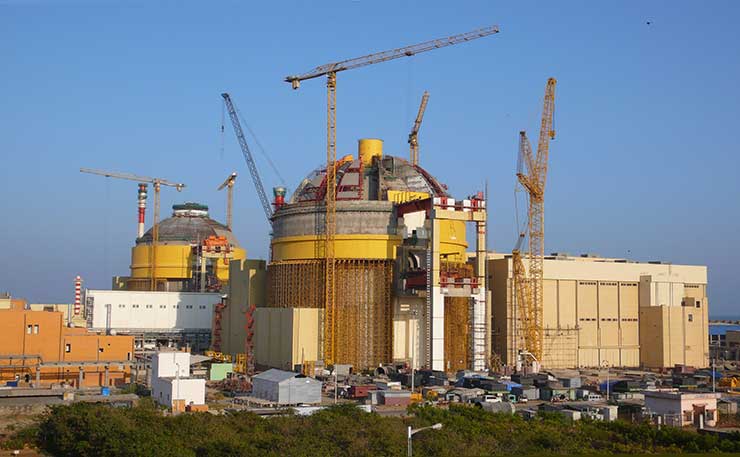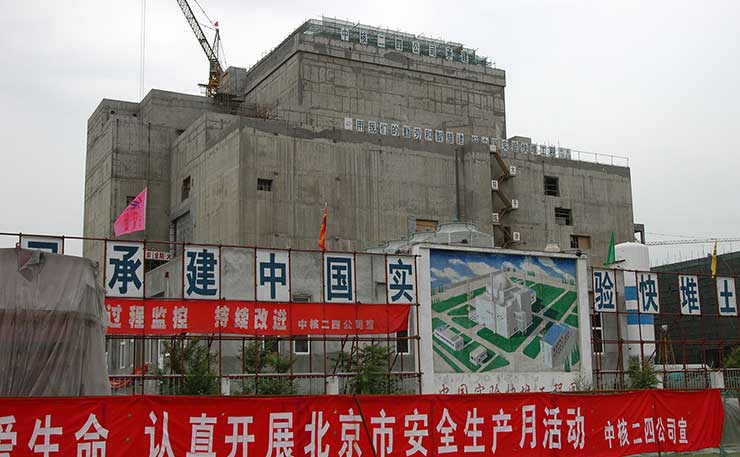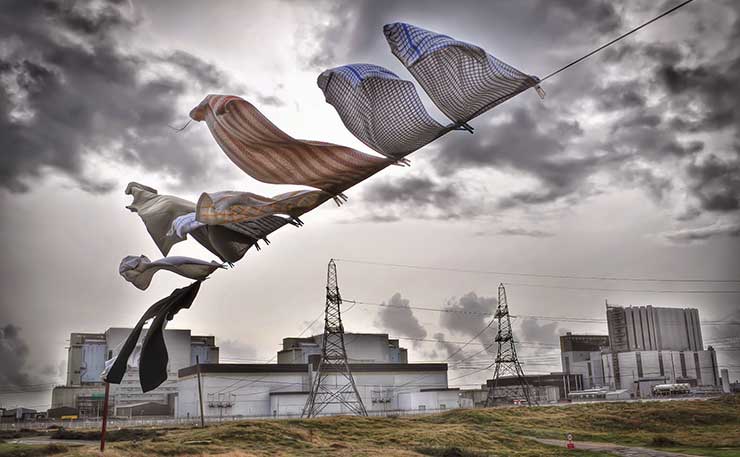Generation IV ‘fast breeder’ reactors have long been promoted by nuclear enthusiasts, writes Jim Green, but Japan’s decision to abandon the Monju fast reactor is another nail in the coffin for this failed technology.
Fast neutron reactors are “poised to become mainstream” according to the World Nuclear Association (WNA). But data provided by the WNA itself gives the lie to the claim.
The WNA lists eight “current” fast reactors, but one of those reactors hasn’t begun operating and another (Monju) has just been put out of its misery. Let’s say there are six ‘operable’ fast reactors (one isn’t operating but might in the future ‒ hence the term ‘operable’). Here’s the historical pattern based on WNA tables: 1976 ‒ 7 operable fast reactors; 1986 ‒ 11; 1996 ‒ 7; 2006 ‒ 6; 2016 ‒ 6.
Of course there’s always tomorrow: the WNA lists 13 fast reactors projects under “active development” for “near- to mid-term deployment”. But a large majority of those 13 projects ‒ perhaps all of them ‒ lack approval and funding. Few if any will get off the ground.
Fast reactors aren’t becoming mainstream. One after another country has abandoned the technology. Nuclear physicist Thomas Cochran summarises the history: “Fast reactor development programs failed in the: 1) United States; 2) France; 3) United Kingdom; 4) Germany; 5) Japan; 6) Italy; 7) Soviet Union/Russia 8) U.S. Navy and 9) the Soviet Navy. The program in India is showing no signs of success and the program in China is only at a very early stage of development.”
The latest setback was the decision of the Japanese government at an extraordinary Cabinet meeting on September 21 to abandon plans to restart the Monju fast breeder reactor.

Monju reached criticality in 1994 but was shut down in December 1995 after a sodium coolant leak and fire. The reactor didn’t restart until May 2010, and it was shut down again three months later after a fuel handling machine was accidentally dropped in the reactor during a refuelling outage.
In November 2012, it was revealed that the Japan Atomic Energy Agency had failed to conduct regular inspections of almost 10,000 out of a total 39,000 pieces of equipment at Monju, including safety-critical equipment.
In November 2015, the Nuclear Regulation Authority declared that the Japan Atomic Energy Agency was “not qualified as an entity to safely operate” Monju. Education minister Hirokazu Matsuno said on 21 September 2016 that attempts to find an alternative operator have been unsuccessful.
The government has already spent 1.2 trillion yen (US$12bn) on Monju. The government calculated that it would cost another 600 billion yen (US$6bn) to restart Monju and keep it operating for another 10 years.
Decommissioning also has a hefty price-tag ‒ far more than for conventional light-water reactors. According to a 2012 estimate by the Japan Atomic Energy Agency, decommissioning Monju will cost an estimated 300 billion yen (US$3bn).
So Japan will have wasted over US$15 billion on the Monju fiasco. Perhaps those responsible will argue that the figure pales into insignificance compared to the estimated long-term costs of around US$500 billion arising from the Fukushima disaster.
Allison MacFarlane, former chair of the US Nuclear Regulatory Commission, recently made this sarcastic assessment of fast reactor technology: “These turn out to be very expensive technologies to build. Many countries have tried over and over. What is truly impressive is that these many governments continue to fund a demonstrably failed technology.”
Japan neatly illustrates MacFarlane’s bemusement. Despite the Monju fiasco, the Japanese government wants to stay involved in the fast reactor game, either by restarting the Joyo experimental fast reactor (shut down since 2007 due to damage to reactor core components) or pursuing pursue joint research with France.
Why would Japan continue its involvement in fast reactors? Most likely, the government has no interest in fast reactors per se, but giving up would make it more difficult to justify continuing with the partially-built Rokkasho reprocessing plant. Providing plutonium fuel for fast reactors was one of the main justifications for Rokkasho.
Rokkasho has been an even more expensive white elephant than Monju. Its scheduled completion in 1997 has been delayed by more than 20 times due to technical glitches and other problems, and its construction cost is now estimated at 2.2 trillion yen (US$22bn) ‒ three times the original estimate.
Japan has wasted around US$37 billion on Monju (US$15bn) and Rokkasho (US$22bn) and plans to continue to throw good money after bad. According to the International Panel on Fissile Materials, if Rokkasho operates it is expected to increase the electricity bills of Japan’s ratepayers by about US$100 billion over the next 40 years.
India’s failed fast reactor program
India’s fast reactor program has also been a failure. The budget for the Fast Breeder Test Reactor (FBTR) was approved in 1971 but the reactor was delayed repeatedly, attaining first criticality in 1985. It took until 1997 for the FBTR to start supplying a small amount of electricity to the grid. The FBTR’s operations have been marred by several accidents.
Preliminary design work for a larger Prototype Fast Breeder Reactor (PFBR) began in 1985, expenditures on the reactor began in 1987/88 and construction began in 2004 ‒ but the reactor still hasn’t started up. Construction has taken more than twice the expected period.

In July 2016, the Indian government announced yet another delay, and there is scepticism that the scheduled start-up in March 2017 will be realised. The PFBR’s cost estimate has gone up by 62 per cent.
India’s Department of Atomic Energy (DAE) has for decades projected the construction of hundreds of fast reactors ‒ for example a 2004 DAE document projected 262.5 gigawatts (GW) of fast reactor capacity by 2050. But India has a track record of making absurd projections for both fast reactors and light-water reactors ‒ and failing to meet those targets by orders of magnitude.
Princeton academic M.V. Ramana writes: “Breeder reactors have always underpinned the DAE’s claims about generating large quantities of electricity. Today, more than six decades after the grand plans for growth were first announced, that promise is yet to be fulfilled. The latest announcement about the delay in the PFBR is yet another reminder that breeder reactors in India, like elsewhere, are best regarded as a failed technology and that it is time to give up on them.”
Russia’s snail-paced program
Russia’s fast reactor program is the only one that could be described as anything other than a failure. But it hasn’t been a roaring success either.
Three fast reactors are in operation in Russia ‒ BOR-60 (start-up in 1969), BN-600 (1980) and BN-800 (2014). There have been 27 sodium leaks in the BN-600 reactor, five of them in systems with radioactive sodium, and 14 leaks were accompanied by burning of sodium.
The Russian government published a decree in August 2016 outlining plans to build 11 new reactors over the next 14 years. Of the 11 proposed new reactors, three are fast reactors: BREST-300 near Tomsk in Siberia, and two BN-1200 fast reactors near Ekaterinburg and Chelyabinsk, near the Ural mountains. However, like India, the Russian government has a track record of projecting rapid and substantial nuclear power expansion ‒ and failing miserably to meet the targets.
As Vladimir Slivyak recently noted in Nuclear Monitor: “While Russian plans looks big on paper, it’s unlikely that this program will be implemented. It’s very likely that the current economic crisis, the deepest in history since the USSR collapsed, will axe the most of new reactors.”
While the August 2016 decree signals new interest in reviving the BN-1200 reactor project, it was indefinitely suspended in 2014, with Rosatom citing the need to improve fuel for the reactor and amid speculation about the cost-effectiveness of the project.
In 2014, Rosenergoatom spokesperson Andrey Timonov said the BN-800 reactor, which started up in 2014, “must answer questions about the economic viability of potential fast reactors because at the moment ‘fast’ technology essentially loses this indicator [when compared with]commercial VVER units.”
China’s program going nowhere fast
Australian nuclear advocate Geoff Russell cites the World Nuclear Association (WNA) in support of his claim that China expect fast reactors “to be dominating the market by about 2030 and they’ll be mass produced”.
Does the WNA paper support the claim? Not at all. China has a 20 MWe experimental fast reactor, which operated for a total of less than one month in the 63 months from criticality in July 2010 to October 2015. For every hour the reactor operated in 2015, it was offline for five hours, and there were three recorded reactor trips.
China also has plans to build a 600 MWe ‘Demonstration Fast Reactor’ and then a 1,000 MWe commercial-scale fast reactor. Whether those reactors will be built remains uncertain ‒ the projects have not been approved ‒ and it would be another giant leap from a single commercial-scale fast reactor to a fleet of them.

According to the WNA, a decision to proceed with or cancel the 1,000 MWe fast reactor will not be made until 2020, and if it proceeds, construction could begin in 2028 and operation could begin in about 2034.
So China might have one commercial-scale fast reactor by 2034 ‒ but probably won’t ‒ and Russell’s claim that fast reactors will be “dominating the market by about 2030” is jiggery-pokery of the highest order and the lowest repute.
According to the WNA, China envisages 40 GW of fast reactor capacity by 2050. A far more likely scenario is that China will have 0 GW of fast reactor capacity by 2050. And even if the 40 GW target was reached, it would still only represent around one-sixth of total nuclear capacity in China in 2050 according to the WNA ‒ fast reactors still wouldn’t be “dominating the market” even if capacity grows 2000-fold from 20 MW (the experimental reactor) to 40 GW.
Travelling waves and the non-existent ‘integral fast reactor’
Perhaps the travelling-wave fast reactor popularised by Bill Gates will come to the rescue? Or perhaps not. According to the WNA, China General Nuclear Power and Xiamen University are reported to be cooperating on R&D, but the Ministry of Science and Technology, China National Nuclear Corporation, and the State Nuclear Power Technology Company are all sceptical of the travelling-wave reactor concept.
Perhaps the ‘integral fast reactor‘ (IFR) championed by James Hansen and Australia’s self-styled ‘ecomodernists’ will come to the rescue? Or perhaps not. The UK and US governments have been considering building IFRs (specifically GE Hitachi’s ‘PRISM’ design) for plutonium disposition ‒ but it is almost certain that both countries will choose different methods to manage plutonium stockpiles.
In a video that New Matilda has on at least three occasions encouraged readers to watch, Hansen claims that an IFR R&D program in the U.S. was terminated due to pressure from environmentalists with devious motives: “I think it was because of the influence of the anti-nuclear people who realised that if this newer technology were developed it would mean that we would have an energy source which is practically inexhaustible − it could last for billions of years − and they succeeded in getting the Clinton administration to terminate the R&D for the fourth generation nuclear power plants.”
So Hansen lines up with far-right nuts who claim that environmentalists want everyone living in caves. Wrong, stupid, and offensive ‒ no wonder he is having so little success winning over environmentalists. As Hansen himself noted in the lead-up to UN COP21 climate conference in December 2015, the Climate Action Network, representing all the major environmental groups at COP21, opposes nuclear power.
In South Australia, nuclear lobbyists united behind a push for IFRs/PRISMs, and they would have expected to persuade a stridently pro-nuclear Royal Commission to endorse their ideas. But the Royal Commission completely rejected the proposal, noting in its May 2016 report that advanced fast reactors are unlikely to be feasible or viable in the foreseeable future; that the development of such a first-of-a-kind project would have high commercial and technical risk; that there is no licensed, commercially proven design and development to that point would require substantial capital investment; and that electricity generated from such reactors has not been demonstrated to be cost competitive with current light water reactor designs.
A future for fast reactors?
Just 400 reactor-years of worldwide experience have been gained with fast reactors. There is 42 times more experience with conventional reactors (16,850 reactor-years). And most of the experience with fast reactors suggests they are more trouble than they are worth.
Apart from the countries mentioned above, there is very little interest in pursuing fast reactor technology. Germany, the UK and the US cancelled their prototype breeder reactor programs in the 1980s and 1990s.
France is considering building a fast reactor (ASTRID) despite the country’s unhappy experience with the Phénix and Superphénix reactors. But a decision on whether to construct ASTRID will not be made until 2019/20.

The performance of the Superphénix reactor was as dismal as Monju. It was meant to be the world’s first commercial fast reactor but in the 13 years of its miserable existence it rarely operated ‒ its ‘Energy Unavailability Factor’ was 90.8% according to the IAEA.
A 2010 article in the Bulletin of the Atomic Scientists summarised the worldwide failure of fast reactor technology: “After six decades and the expenditure of the equivalent of about $100 billion, the promise of breeder reactors remains largely unfulfilled…. The breeder reactor dream is not dead, but it has receded far into the future. In the 1970s, breeder advocates were predicting that the world would have thousands of breeder reactors operating this decade. Today, they are predicting commercialization by approximately 2050.”
Spinning fast
While fast reactors face a bleak future, the rhetoric will persist. Australian academic Barry Brook wrote a puff-piece about “newer fast reactors” for the Murdoch press in 2009. On the same day he said on his website that “although it’s not made abundantly clear in the article”, he expects conventional reactors to play the major role for the next two to three decades but chose to emphasise fast reactors “to try to hook the fresh fish”.
That’s one part of the nuclear lobbyists’ game-plan − pretending that fast reactors and other Generation IV reactor concepts are near-term prospects and being less than “abundantly clear” about the truth.
Brook is also less than abundantly clear about the WMD proliferation risks associated with fast reactors. He claims that IFRs could not be used “to generate weapons-grade material” and Hansen claims they “could be inherently free from the risk of proliferation”.
Both claims are false.
Dr George Stanford, who worked on an IFR R&D program in the US, notes that proliferators “could do [with IFRs]what they could do with any other reactor − operate it on a special cycle to produce good quality weapons material.”
A tightening of the nuclear safeguards system (described by Prof. Jim Falk as “half-blind, toothless and mute”) would reduce proliferation risks. But Brook, Hansen and Russell have made no contribution whatsoever to the laborious work of pressuring governments to tighten safeguards and it’s unlikely they ever will. So much easier to keep spinning, as with Brook’s claim that nuclear weapons proliferation is under “strong international oversight”.
Brook cites a book by Tom Blees in support of that statement. But Blees doesn’t argue that the nuclear industry is under strong international oversight ‒ he argues that “fissile material should all be subject to rigorous international oversight” (emphasis added) and he urges a radical overhaul of the safeguards system. Brook’s conflation between reality and wishful thinking is perhaps the most common tactic of the nuclear propagandists, particularly when they’re spinning about Generation IV fast reactors.
Donate To New Matilda
New Matilda is a small, independent media outlet. We survive through reader contributions, and never losing a lawsuit. If you got something from this article, giving something back helps us to continue speaking truth to power. Every little bit counts.





